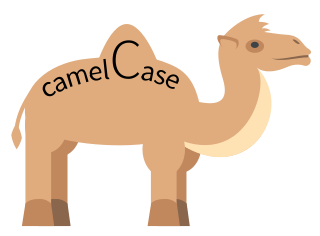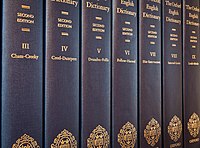
Camel case is the practice of writing phrases without spaces or punctuation, indicating the separation of words with a single capitalized letter, and the first word starting with either case. Common examples include "iPhone" and "eBay". It is also sometimes used in online usernames such as "johnSmith", and to make multi-word domain names more legible, for example in advertisements.
In English writing, quotation marks or inverted commas, also known informally as quotes, talking marks, speech marks, quote marks, quotemarks or speechmarks, are punctuation marks placed on either side of a word or phrase in order to identify it as a quotation, direct speech or a literal title or name. Quotation marks may be used to indicate that the meaning of the word or phrase they surround should be taken to be different from that typically associated with it, and are often used in this way to express irony. They also sometimes appear to be used as a means of adding emphasis, although this usage is usually considered incorrect.

The Chicago Manual of Style is a style guide for American English published since 1906 by the University of Chicago Press. Its 17 editions have prescribed writing and citation styles widely used in publishing. It is "one of the most widely used and respected style guides in the United States". The guide specifically focuses on American English and deals with aspects of editorial practice, including grammar and usage, as well as document preparation and formatting. It is available in print as a hardcover book, and by subscription as a searchable website as The Chicago Manual of Style Online. The online version provides some free resources, primarily aimed at teachers, students, and libraries.
The World Wide Web Consortium (W3C)'s Web Accessibility Initiative (WAI) is an effort to improve the accessibility of the World Wide Web for people with disabilities. People with disabilities may encounter difficulties when using computers generally, but also on the Web. Since people with disabilities often require non-standard devices and browsers, making websites more accessible also benefits a wide range of user agents and devices, including mobile devices, which have limited resources.

The AP Stylebook, also known by its full name The Associated Press Stylebook and Briefing on Media Law, is an American-English grammar style and usage guide created by American journalists working for or connected with the Associated Press. Although it is sold as a guide for reporters, it has become the leading reference for most forms of public-facing corporate communication over the last half-century. The Stylebook offers a basic reference to American-English grammar, punctuation and principles of reporting, including many definitions and rules for usage as well as styles for capitalization, abbreviation, spelling and numerals.
Copy editing is the process of revising written material to improve readability and fitness, as well as ensuring that text is free of grammatical and factual errors. The Chicago Manual of Style states that manuscript editing encompasses "simple mechanical corrections through sentence-level interventions to substantial remedial work on literary style and clarity, disorganized passages, baggy prose, muddled tables and figures, and the like ". In the context of print publication, copy editing is done before typesetting and again before proofreading. Outside of traditional book and journal publishing, the term copy editing is sometimes incorrectly referred to as proofreading, or the term copy editing sometimes includes additional tasks.
Computer accessibility refers to the accessibility of a computer system to all people, regardless of disability type or severity of impairment. The term accessibility is most often used in reference to specialized hardware or software, or a combination of both, designed to enable the use of a computer by a person with a disability or impairment. Computer accessibility often has direct positive effects on people with disabilities.
An acronym is a word or name formed from the initial components of a longer name or phrase, usually using individual initial letters, as in NATO or EU, but sometimes using syllables, as in Benelux, or a mixture of the two, as in radar. Similarly, acronyms are sometimes pronounced as words, as in NASA or UNESCO, sometimes as the individual letters, as in FBI or ATM, or a mixture of the two, as in JPEG or IUPAC.
Web accessibility is the inclusive practice of ensuring there are no barriers that prevent interaction with, or access to, websites on the World Wide Web by people with physical disabilities, situational disabilities, and socio-economic restrictions on bandwidth and speed. When sites are correctly designed, developed and edited, generally all users have equal access to information and functionality.
Technical communication is a means to convey scientific, engineering, or other technical information. Individuals in a variety of contexts and with varied professional credentials engage in technical communication. Some individuals are designated as technical communicators or technical writers. These individuals use a set of methods to research, document, and present technical processes or products. Technical communicators may put the information they capture into paper documents, web pages, computer-based training, digitally stored text, audio, video, and other media. The Society for Technical Communication defines the field as any form of communication that focuses on technical or specialized topics, communicates specifically by using technology or provides instructions on how to do something. More succinctly, the Institute of Scientific and Technical Communicators defines technical communication as factual communication, usually about products and services. The European Association for Technical Communication briefly defines technical communication as "the process of defining, creating and delivering information products for the safe, efficient and effective use of products ".
Tableless web design is a web design method that avoids the use of HTML tables for page layout control purposes. Instead of HTML tables, style sheet languages such as Cascading Style Sheets (CSS) are used to arrange elements and text on a web page.
Sentence spacing concerns how spaces are inserted between sentences in typeset text and is a matter of typographical convention. Since the introduction of movable-type printing in Europe, various sentence spacing conventions have been used in languages with a Latin alphabet. These include a normal word space, a single enlarged space, and two full spaces.
The Web Content Accessibility Guidelines (WCAG) are part of a series of web accessibility guidelines published by the Web Accessibility Initiative (WAI) of the World Wide Web Consortium (W3C), the main international standards organization for the Internet. They are a set of recommendations for making Web content more accessible, primarily for people with disabilities—but also for all user agents, including highly limited devices, such as mobile phones. WCAG 2.0, were published in December 2008 and became an ISO standard, ISO/IEC 40500:2012 in October 2012. WCAG 2.1 became a W3C Recommendation in June 2018.
Microsoft UI Automation (UIA) is an application programming interface (API) that allows one to access, identify, and manipulate the user interface (UI) elements of another application.

A style guide or manual of style is a set of standards for the writing, formatting and design of documents. It is often called a style sheet, although that term also has other meanings. The standards can be applied either for general use, or be required usage for an individual publication, a particular organization, or a specific field.
The full stop, period or full point. is a punctuation mark. It is used for several purposes, most often to mark the end of a declarative sentence ; this sentence-terminal use, alone, defines the strictest sense of full stop.

A Manual for Writers of Research Papers, Theses, and Dissertations is a style guide for writing and formatting research papers, theses, and dissertations and is published by the University of Chicago Press.
Sentence spacing guidance is provided in many language and style guides. The majority of style guides that use a Latin-derived alphabet as a language base now prescribe or recommend the use of a single space after the concluding punctuation of a sentence.





